Myron G. Best. Igneous and metamorphic 2003 Blackwell Science
Подождите немного. Документ загружается.

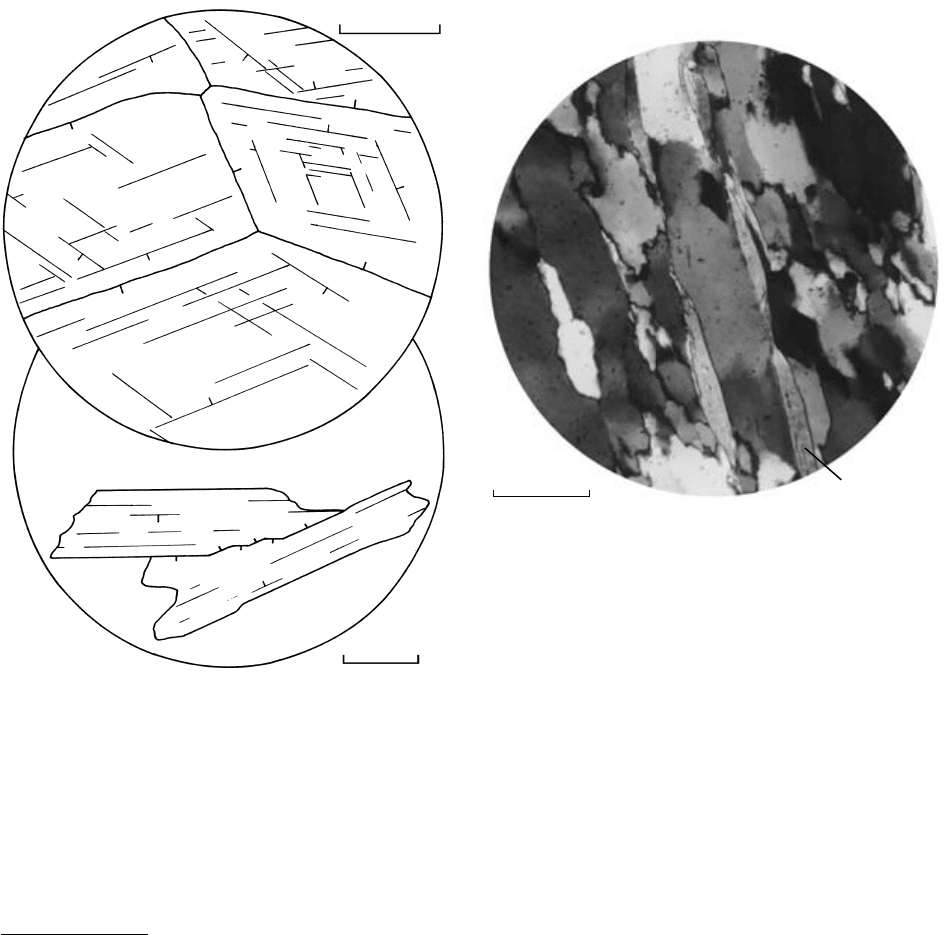
Chemical Zoning. Larger grains of solid solutions,
especially porphyroblasts, in metamorphic rocks are
commonly chemically inhomogeneous. Compositional
zoning more or less concentric with the grain margin
can develop by fractional crystallization; the interior
of the growing porphyroblast was isolated from the
surrounding reactant phases in the matrix because
changes in metamorphic conditions proceeded faster
than compositional equilibration by ionic diffusion
(Section 16.5.2). During growth as a product phase
from a continuous mineral reaction, there was a con-
tinuous change in the composition of the material
supplied to the surface of the enlarging porphyroblast.
For zoning to be preserved after growth, the rate of
diffusion of unevenly concentrated ions must be very
slow, as otherwise the grain would have at least par-
tially homogenized and equilibrated with its surround-
ings. If no retrograde equilibration has taken place,
the rim composition is part of the mineral assemblage
of neighboring matrix phases produced under peak
metamorphic conditions. Internal compositions and
any inclusions can be used to infer earlier metamor-
phic conditions (Figure 16.35). In some cases, parts of
zoned minerals can be dated, allowing construction of
P–T–t paths.
Porphyroblasts of garnet are widespread and com-
monly zoned. Although the zoning is not optically
visible in thin section, spot analyses using an electron
microprobe reveal the nature of zoning (Figure 16.34).
Back-scatter electron images can also show the zon-
ing, provided it involves a change in average atomic
number (e.g. changes in Fe versus Mg).
Many zoned almandine-rich garnets in pelites are
produced by the continuous prograde reaction chlorite
quartz garnet water. Because Mn-rich garnets
are stable at lower temperatures than more Fe–Mg-rich
ones, the cores of garnets typically have much higher
Mn, or spessartine end-member, concentrations.
Chernoff and Carlson (1999) have found that some
Fe–Mg–Mn garnets apparently achieved chemical
equilibrium with their surroundings during diffusion-
controlled growth but Ca and trace elements in them
did not because of slow rates of intergranular diffusion.
Caution needs to be exercised in using thermobaro-
meters based on Ca in garnet.
Interpretation of concentration maps and zoning
profiles can be challenging, given the complexities of
Evolution of Imposed Metamorphic Fabrics: Processes and Kinetics
527
(b)
(a)
87
70 80
77
0.2 mm
77
81
135
81
88
78
85
85
82
82
82
85
85
82
0.2 mm
80
85
88
87
75
138
88
Quartz
Muscovite
0 0.5mm
17.6 Compromised grain boundary configurations in aggregates
of amphibole and biotite. (a) Triple junctions depart from
120° angles because of the influence of the surface-energy
anisotropy of the adjoined monoclinic amphibole grains.
(b) Corrugated or sawtooth boundary between two biotite
flakes with oblique (001) cleavages. Compared to a smooth
boundary of lesser surface area, the sawtooth one has larger
area but smaller overall energy and is more stable. Redrawn
from Kretz (1966).
17.7 Stable texture in a quartz–muscovite schist under cross-
polarized light. Euhedral flakes of mica are interspersed
among unusually shaped, rectangular quartz grains. In a
monomineralic quartzite, grain equilibrated shapes would be
relatively equant polygons meeting at 120° triple junctions.

some growth patterns (Figure 17.2), in some instances
compounded by concurrent bodily rotation of the
entire porphyroblasts (see Figure 17.30), overgrowths
on deformed matrix foliation (see Figure 17.32), and
the cut effect (discussed later).
Inclusions. Most porphyroblasts contain inclusions of
one or more other crystalline phases. Although these
poikiloblasts are unstable as a result of the internal
surface area relative to an inclusion-free porphyroblast
of equivalent composition and size, the inclusions are
effectively armoured against reactive communication
with matrix phases because of sluggish kinetics and,
hence, can persist indefinitely. Poikiloblasts potentially
provide further insights into processes and events dur-
ing their growth in addition to any information from
compositional zoning. Inclusions are petrogenetically
useful for the following reasons:
1. Some are preserved reactant phases and provide in-
formation on the nature of mineral reactions that
created the poikiloblast. For example, the first
appearance of andalusite or kyanite (depending on
P) in prograding pelites might be related to the
discontinuous reaction decomposing pyrophyllite
17.1 Al
2
Si
4
O
10
(OH)
2
Al
2
SiO
5
3SiO
2
H
2
O
The three moles of quartz produced for every one
mole of Al
2
SiO
5
cannot readily be removed by dif-
fusion of Si nor physically “bulldozed” in front of
the advancing crystal-growth front; consequently,
byproduct quartz remains as armoured inclusions
within the andalusite or kyanite poikiloblast. Some
or all of the reactant phases involved in growth of
the poikiloblast may have been consumed by sub-
sequent reactions in the surrounding matrix but
their preservation within the poikiloblast testifies of
their prior existence. Other inclusions, such as zir-
cons, may never have participated in poikiloblast-
forming reactions and were simply physically
engulfed as an “inert” phase into the growing poik-
iloblast. Inert graphite particles are adsorbed along
preferred crystallographic domains in growing
andalusite (Figure 14.10).
2. Some inclusions can be used as geothermobarome-
ters. An example was described in Section 16.11.2
of zoned garnet poikiloblasts in the Wopmay
orogen; the presence of kyanite inclusions in the
interior and sillimanite in the outer parts of the
poikiloblasts supports a decompression path dur-
ing growth determined by thermobarometry.
3. Some inclusions can be dated isotopically, furnish-
ing an absolute chronology for construction of
P–T–t paths.
4. Insights can be gained from trails of inclusions
about the history of deformation of the rock, either
before or during poikiloblast growth. This is de-
scribed in Section 17.3.3.
Exsolution Textures and Symplectites. As intensive
variables change, destabilized, initially homogeneous
minerals can experience breakdown into two or more
crystalline phases. Careful attention to textures and
awareness of critical phase equilibria may be necess-
ary to distinguish these exsolution intergrowths from
superficially similar inclusions in poikiloblasts.
The most widespread exsolution texture is that seen
in alkali feldspar perthites. Though previously dis-
cussed as forming in slowly cooled magmatic granitic
systems (Figures 5.17 and 5.18a), perthites are also
common in slowly cooled high-grade metamorphic
rocks. Some pyroxenes in high-grade rocks also display
exsolution into Ca-rich and Ca-poor intergrowths.
Symplectites, or symplectitic intergrowths, are gen-
erally two-phase vermicular (wormlike) breakdown
products of high P–T solid solutions. Common ones
include cordierite quartz orthopyroxene after
garnet and plagioclase diopside replacing Na–Al-
rich omphacitic pyroxene (Figure 15.11) in mafic
eclogite-facies rocks. Other symplectites result from
mutual reaction between two adjacent unstable phases,
such as orthopyroxene spinel clinopyroxene at the
junction between olivine and plagioclase (Figure 16.6).
Symplectites result from diffusion-controlled reactions
where product phases grow as close as possible to
reaction sites, or to the reaction sites liberating the
slowest diffusing component.
17.2 DUCTILE FLOW
Anisotropic tectonite fabric is characteristic of broad
regional terranes in orogenic belts that constitute the
most widely exposed metamorphic rock on Earth.
Under the elevated pressures and temperatures that
prevail in the deep crustal parts of these orogens and
in concert with generally slow rates of strain under
nonhydrostatic states of stress, rocks deform by grain-
scale, pervasive ductile flow. As a result, metamorphic
bodies change shape, or strain, without loss of cohe-
sion. Cracking, or fracturing, and subsequent frictional
sliding can function locally in metamorphic rocks at
high strain rates and where fluids reduce the effect-
ive stress, but these brittle mechanisms are typically
focused along shallow crustal faults at lower pressures
and temperatures than those prevailing in metamor-
phic terranes. Broadly concurrent recrystallization and
ductile deformation is responsible for the characteristic
anisotropic tectonite fabric of the class of rocks called
tectonites that typify regional metamorphic terranes in
orogens of all ages.
Ductile flow is a standard topic of structural geo-
logy textbooks, such as Twiss and Moores (1992; see
528 Igneous and Metamorphic Petrology
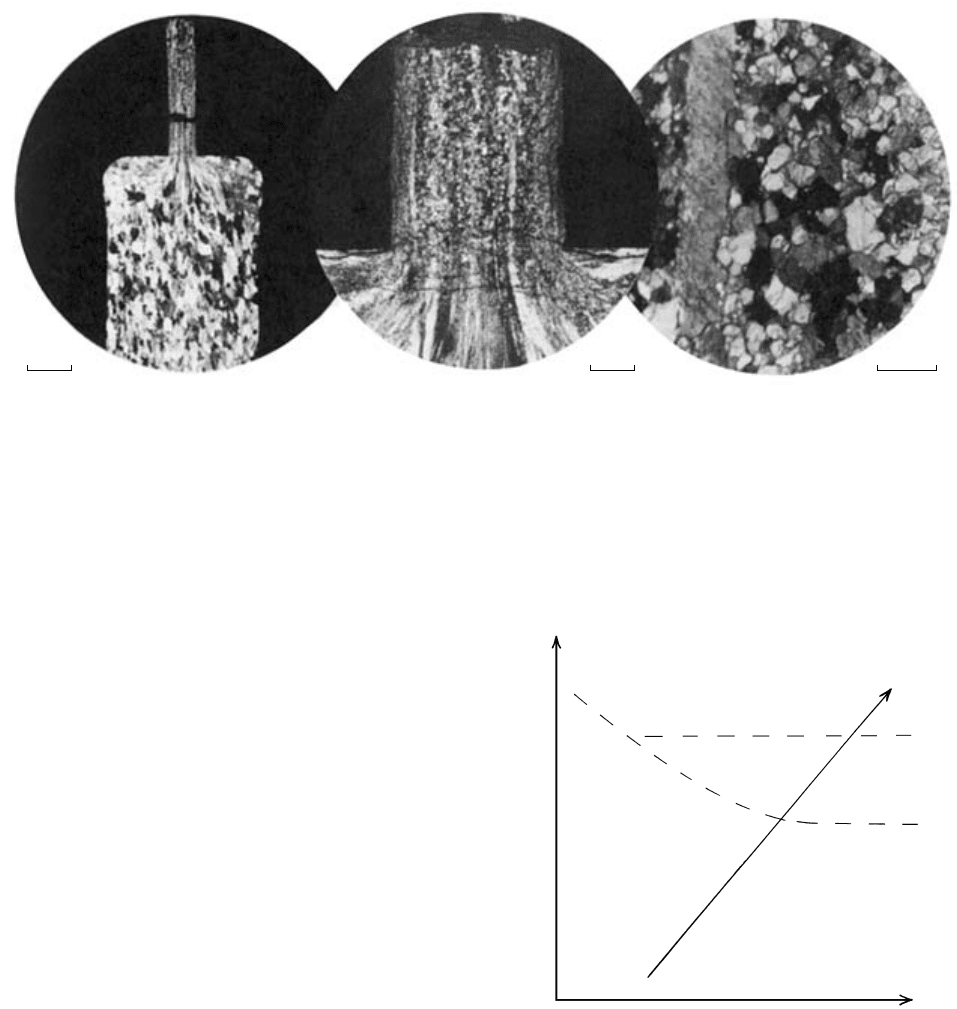
also Sections 8.1 and 8.2.1 and Snoke et al., 1998,
pp. 9–15). However, the “gray area” between structural
geology and metamorphic petrology—or structural
petrology—provides rich insights into the develop-
ment of tectonite fabrics and is accordingly pursued
here. Historically, most of our initial understanding
of ductile flow came from metallurgical practices and
research because shaping pieces of metal by bending,
extruding, and rolling involves ductile flow. But, dur-
ing the decades of the late twentieth century, experi-
mental studies on the ductile behavior of rocks and
rock-forming minerals flourished (Figure 17.8), as did
careful observations from the scale of an outcrop down
to that seen by an electron microscope.
Large-scale ductile deformation of rock bodies is
accomplished by the integrated effects of two basic
grain-scale mechanisms that act in a pervasive manner
throughout a rock volume: first, a chemical transfer
called diffusive creep and, second, intracrystalline
plasticity and related recrystallization called dislocation
slip and creep. Both mechanisms are stress-induced
and are thermally activated; that is, promoted at higher
T. They result in grain strain, but do not modify the
crystalline nature of the grains. Each ductile mechan-
ism has associated kinetic rates, an essentially distinct
associated fabric, and a specific range of conditions
over which it is the dominant mechanism of ductile
flow (Figure 17.9). A third process—called grain-
boundary sliding—involves rotational and translation
motion between neighboring grains to accommodate
gaps and overlaps in aggregates as they deform by the
other two mechanisms.
17.2.1 Diffusive Creep
Mineral grains in nonhydrostatically stressed rocks can
change shape by thermally activated diffusive transfer
Evolution of Imposed Metamorphic Fabrics: Processes and Kinetics
529
2.5 mm .25 mm 0.1 mm
17.8 Solid-state ductile flow in marble produced in the laboratory. A small cylinder of marble at 500°C subjected to a confining pressure of
5 kbar was extruded into a hole in the loading piston (Figure 8.5). The rate of strain in the extruded region was 3 10
7
/s, or the
approximately 100% strain was accomplished in about 35 days. (a) Photomicrograph shows a thin section of the deformed cylinder un-
der cross-polarized light. Extruded neck broke after termination of experiment. (b) Enlarged view of extruded region showing slender
deformation twin lamellae in the calcite grains, especially prominent in and near the extruded region, and region of extensive recrystal-
lization into polygonal grains above them. (c) Enlarged view of granoblastic grain aggregate produced by recrystallization that replaced
intensely strained grains; one slender twin lamella remains. Photographs and information courtesy of Hugh C. Heard. From Heard HC.
1963. Effect of large changes in strain rate in the experimental deformation of Yule marble. J. Geol. 71: 162–195. Reproduced with permis-
sion from University of Chicago Press © 1963.
STRESS
Dislocation slip
Dislocation
creep
creep
and
Diffusive
T
transfer
INCREASING
STRAIN RATE
17.9 Highly generalized deformation map showing the relative
range of conditions over which important mechanisms of duc-
tile deformation occur. Only mechanisms allowing potentially
large amounts of strain by steady-state creep (slow continuous
deformation) are represented. See Twiss and Moores (1992,
p. 387) for more specific details.

of atoms from one part of a grain to another. The
driving force for this diffusion is a gradient in chemical
potential from high- to low-stress sites (Green, 1980).
In general, grains shorten parallel to the maximum
compressive stress axis and lengthen parallel to the
minimum compressive stress (Section 8.1.1). The flat-
tened grains impart a foliation to metamorphic rocks.
Deformation by diffusive transfer has a rheologic
behavior resembling that of Newtonian viscosity where
the time rate of strain is proportional to the applied
shear stress (Section 8.1.3). Like viscous flow, diffusive
transfer is a slow continuous deformation that occurs
under steady shear stress at low strain rates, hence the
appellation diffusive creep.
Three possible creep processes correspond to the
three different diffusion paths in grain aggregates (Fig-
ure 17.1) that have contrasting rates. Diffusion through
the volume of the grain is Nabarro–Herring creep, dif-
fusion along dry grain boundaries is Coble creep, and
via an intergranular fluid is pressure solution.
All three diffusion paths are effective at relatively
high temperatures but other thermally activated mech-
anisms of ductile flow are likewise enhanced and may
supersede the effects of diffusive transfer and creep.
Hence, diffusive creep is generally manifest at relatively
low temperatures of metamorphism, limited perhaps
to the upper greenschist facies. In generally coarser
grained, higher grade metamorphic rocks, paths of dif-
fusion are lengthened and there is proportionately less
surface area to volume; both factors decrease the effect-
iveness of diffusive transfer. In addition, higher grade
rocks may have little fluid in them as a result of pro-
grade devolatilization reactions. Locally, however, as in
brittle fault and ductile shear zones, grain size can be
reduced by cataclasis (Section 8.2.1 and Figure 8.7)
and by dynamic recrystallization (discussed later),
respectively. In these sheets of deformed rock, strain
can be enhanced by diffusive creep.
Pressure Solution. Probably the most effective mech-
anism of diffusive creep is pressure solution because
of the enhanced kinetics where intergranular fluids are
present.
The work of stressing a crystal imparts increasing
energy as strain is locked in; equilibrium atomic bond
angles and distances are changed. In the presence of a
fluid, a stressed, higher-energy crystal is more soluble
relative to neighboring ones in the communicating
fluid that are not stressed and the surface of a single
grain where the normal stress is greatest is more
soluble than where the stress is less. As a result of this
Riecke’s principle, higher concentrations of dissolved
chemical species are created in intergranular fluids
adjacent to more stressed grains or grain parts. The
resulting concentration (activity) gradient drives ionic
diffusion from more stressed grain margins to less
stressed surfaces where grain growth takes place. In a
nonhydrostatically stressed rock permeated by an inter-
granular fluid, this differential pressure solution can
produce a significant change in shape of the rock body.
Pressure solution depends on the availability of relat-
ively soluble minerals under metamorphic conditions,
the most common of which are calcite and quartz. The
necessary fluid can be derived from different sources
(Section 16.6.1), but fluid-liberating compaction and
prograde reactions are probably significant.
Pressure solution can be manifest in different ways
in rocks. It locally creates a significant loss in rock
volume. In some conglomerates, depressions on the
surfaces of clasts are created by the pressure of neigh-
boring impinging clasts causing pressure solution. In
fine-grained sedimentary and low-grade metamorphic
rocks, dissolution surfaces are repetitively spaced
surfaces millimeters to centimeters apart that define a
spaced cleavage (Section 15.1.1; see also Twiss and
Moores, 1992, Chapter 13). Some of these dissolution
surfaces give a false impression of differential shear
movement parallel to the surface (Figure 15.4).
Irregular stylolites in carbonate rocks where fossils are
sharply truncated are examples. In low-grade meta-
morphic rocks, less soluble phyllosilicates and other
“inert” minerals, such as zircon, can be concentrated
along discrete crenulation cleavages where relatively
more soluble quartz has been preferentially dissolved
and removed (Figure 15.3). Pressure solution can also
be manifest on a pervasive grain scale throughout a
rock, imparting a penetrative foliation. Thus, flattened
quartz grains in some schists and phyllites have a film
of insoluble residue on the flat margins and fibrous
overgrowths (“beards”) on the extended margins (Fig-
ure 17.10). These overgrowths resemble mineral pre-
cipitates in the lower stress pressure shadows alongside
rigid objects such as boudins (Figure 15.8b).
The existence of interconnected fluid pathways
along grain boundaries is essential for pressure solu-
tion. Under hydrostatic states of stress, H–O–C fluids
in aggregates occur in isolated pools at grain corners
where the dihedral angle 60° and possibly in tubes
along three grain edges where the dihedral angle 0°
60°. However, Tullis et al. (1996) have demon-
strated experimentally that in feldspar aggregates un-
der nonhydrostatic stress at elevated P and T most grain
boundaries are fully wetted, or the fluid is a continuous
film covering the entire grain boundary; the dihedral
angle is effectively equal to 0°. This deformation-
induced fluid wetting of grain surfaces reduces the
yield strength of the aggregate while increasing the
diffusive transport rate, both by about an order of mag-
nitude. Diffusive creep is promoted at the expense of
plastic dislocation creep, which otherwise prevails at the
P and T of the experimental conditions. Deformation-
enhanced pressure solution accomplishing diffusive
530 Igneous and Metamorphic Petrology
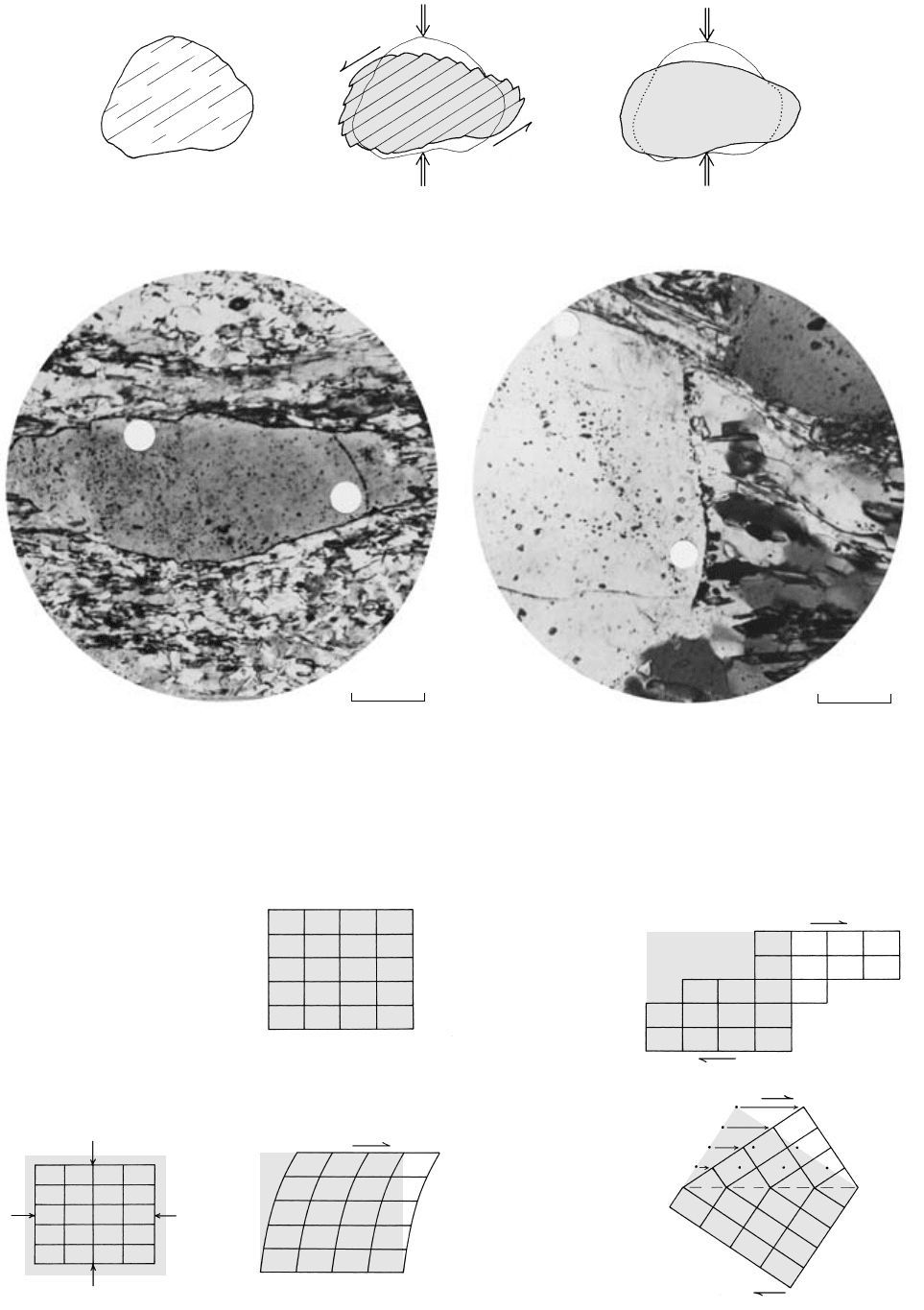
Original grain
(a)
Grain strained by
intracrystalline
plastic slip
O
O
C
Grain strained by
pressure solution
(b)
C
O
0 0.05mm
C
O
(c)
0 0.05mm
17.10 Flattened quartz grains resulting from pressure solution. (a) Schematic comparison of intracrystalline plastic slip and pressure solution,
where C is the corroded dissolution surface resulting from removal of material and O is a segment of the original grain surface marked
by minute insoluble impurities onto which new grain material has been deposited as an overgrowth. The volume of the grain remains
essentially unchanged as material moves from C to O. (b) and (c) Thin sections showing an initially more equant quartz grain that has
been flattened by an overgrowth of optically continuous quartz extending the original grain boundary O into a strain shadow at the
expense of dissolution at the surface C. From Elliott DS. 1973. Diffusion flow laws in metamorphic rocks. Geol. Soc. Am. Bull. 84:
2645–2664. Reproduced with permission of the Geological Society of America, Boulder, Colorado, USA. Copyright © 1973 Geological
Society of America.
Distorted atomic bonds
due to nonhydrostatic
(shear) stress
ELASTIC STRAIN
Shortened interatomic
distances due to
hydrostatic pressure
Original unstrained
crystal lattice
(a)
(b)
(c)
PLASTIC STRAIN
By crystallographically
controlled
intracrystalline slip
(d)
PLASTIC STRAIN
By twinning in
crystallographically
controlled direction
17.11 Contrast between elastic and plastic strains (Figure 8.3) shown by schematic sections through a hypothetical, two-dimensional crystal lat-
tice. Unstrained lattice is shaded. In the lattice strained by twinning (d), the original lattice points are indicated by dots and the
arrows show they have moved progressively farther the more distant they are from the twin plane (dashed light line).
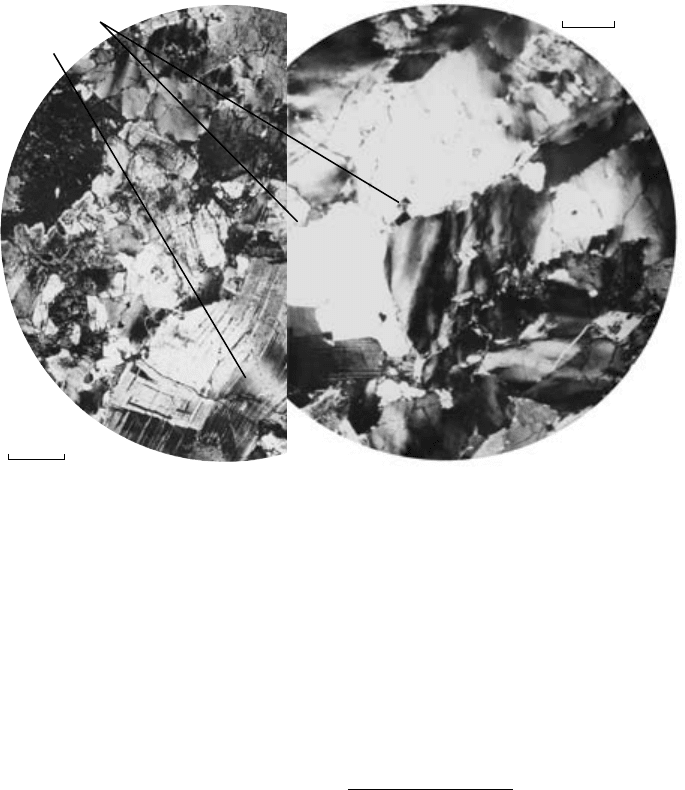
creep has a potentially important bearing on fine-
grained, mylonitic ductile shear zones in the crust
where strain was apparently focused into weaker rock.
Fluid transport appears to be enhanced in the my-
lonitic sheets relative to surrounding rock, if mobility
of chemical elements (Sinha et al., 1986) and infiltra-
tion of meteoric water (Fricke et al., 1992) are any
indication.
17.2.2 Intracrystalline Plastic Deformation
In unstrained crystals, the periodic array of atoms is
maintained in an equilibrium state by interatomic
forces of attraction and repulsion. As stress is applied,
small reversible elastic strains (Section 8.1.1) distort
atomic bonds and interatomic distances are shortened
or lengthened (Figure 17.11a). As the magnitude of a
nonhydrostatic stress increases, permanent bending
and distortion of the atomic structure can be locked
into grains in aggregates. Effects are seen in bent and
otherwise distorted grains, some of which possess un-
dulose or undulatory optical extinction under cross-
polarized light in thin section (Figures 15.17 and
17.12). If P is sufficiently great to inhibit brittle rupture
and resulting dilatancy and where the resolved shear
stress is of sufficient magnitude on particular atomic
planes, parts of a crystal yield plastically by slipping
or twinning on those planes into a new equilibrium
position. This intracrystalline plastic strain changes the
external shape of the crystal but preserves the ordering
of the lattice across the slip or twin plane (Figure
17.11c, d). Groups, or domains, of atomic bonds can
be systematically broken or rotated along specific
crystallographic directions and then reformed into a
new, permanent equilibrium position, while the whole
crystal remains intact and unbroken.
Translation Gliding. In this intracrystalline plastic
mechanism, also simply referred to as slip, discrete
layers of the crystal slide past one another by integral
multiples of fundamental crystallographic units, tem-
porarily breaking and then reforming atomic bonds.
Afterward, the internal lattice is still continuous, cohe-
sion is preserved (the mineral is not cleaved into separ-
ate fragments), and the parts on either side of the slip
panels are still similarly crystallographically oriented;
only the external outline of the crystal has changed.
The flattened overall shape of a mineral grain that
experienced translation gliding, resembling a deck of
slipped playing cards, can be appreciated in Figure
17.11c. The plane on which slip occurs and the direc-
tion of slip in that plane is controlled by the atomic
structure in the crystal. Slip, or glide, planes in crystals
commonly parallel crystallographic directions of dens-
est atomic packing and widest interatomic spacing,
where interplane bonding is weakest. An example is
the (001) plane in micas. These same directions com-
monly parallel crystal growth faces with simple Miller
indices, again as in micas. But the nature of the atoms
in the crystallographic planes is also important, making
for many exceptions.
532 Igneous and Metamorphic Petrology
Plagioclase
Quartz(a) (b)
0 mm 0.5
0mm2
17.12 Slightly deformed granitic rock viewed under cross-polarized light in thin section. Twin lamellae in plagioclase are bent. Most grains,
especially the quartz seen at increased magnification in (b), have distorted crystal lattices and display undulatory optical extinction
wherein different parts of a single grain extinguish at slightly different orientations as the microscope stage is rotated; extinction sweeps
fanlike across the grain. Strained quartz is no longer uniaxial and can have an optic axial angle as much as 20°.
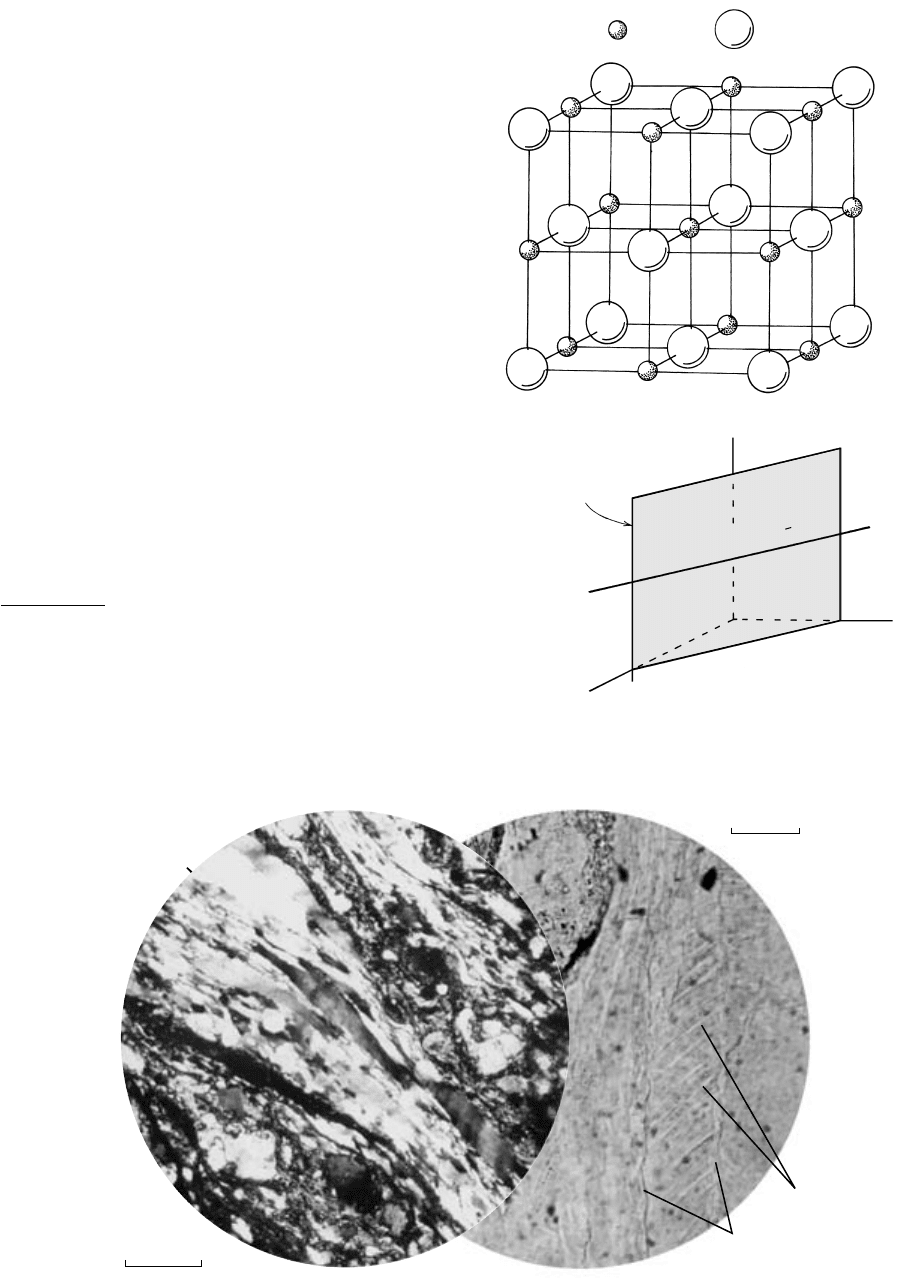
In halite (Figure 17.13), a prominent slip plane is
{110}, of which, because of symmetry, there are six
planes. The slip direction in one of these planes, (110),
is [110]. Although {111} is the orientation of densest
atomic packing, the alternating layers of Na
and Cl
ions have a strong attraction for one another, so it is not
the easiest slip plane. Crystals of rock-forming minerals
possess one or more slip systems that consist of a slip
plane plus the slip direction on it; specific ones will be
favored under a particular range of P, T, and strain rate
(Nicolas and Poirier, 1976, Chapter 5). Widespread
quartz in metamorphic rocks slips on basically two
planes—the basal plane (0001) at low T and a prism
plane {1010} at high T.
Quartz grains strained by intracrystalline plastic slip
at relatively low temperatures and/or at high stress or
high strain rate, such as in many mylonites, are severely
flattened and stretched ribbons, inside of which are
thinner, more or less planar deformation lamellae that
mark the active slip planes (Figure 17.14). Comparison
with Figure 17.15 reveals that several hundreds of per-
cent elongation (extension) can be potentially achieved
by constant-volume plastic slip.
Twin Gliding. In this mechanism (Figures 17.11d and
17.16), a portion of the crystal structure responds to a
local shear stress in such a way as to produce a mirror
image of the original crystal. This twin is called a mech-
anical or deformation twin. The twin plane, which is
the mirror across which the parts are symmetrically
related, may be parallel to a plane of plastic slip in
Evolution of Imposed Metamorphic Fabrics: Processes and Kinetics
533
a
2
a
1
Slip plane
(110)
a
3
Na
+
Cl
−
Slip
direction
[110]
17.13 Atomic structure of halite and one of its six symmetrically
related slip planes {110} and directions.
(a) (b)
Deformation
bands
Deformation
lamellae
Margins of
deformation band
0 mm 0.5
0 mm 0.1
17.14 Deformed quartz in a mylonite viewed under cross-polarized light in thin section. (a) Ribbonlike deformation bands of flattened quartz.
(b) Within the bands are oblique deformation lamellae bounded by slip planes. These lamellae have subtle contrasts in refractive index
and can be discerned by very slight adjustments in optical focus in collimated light to emphasize Becke lines. Compare with Figure 17.15.
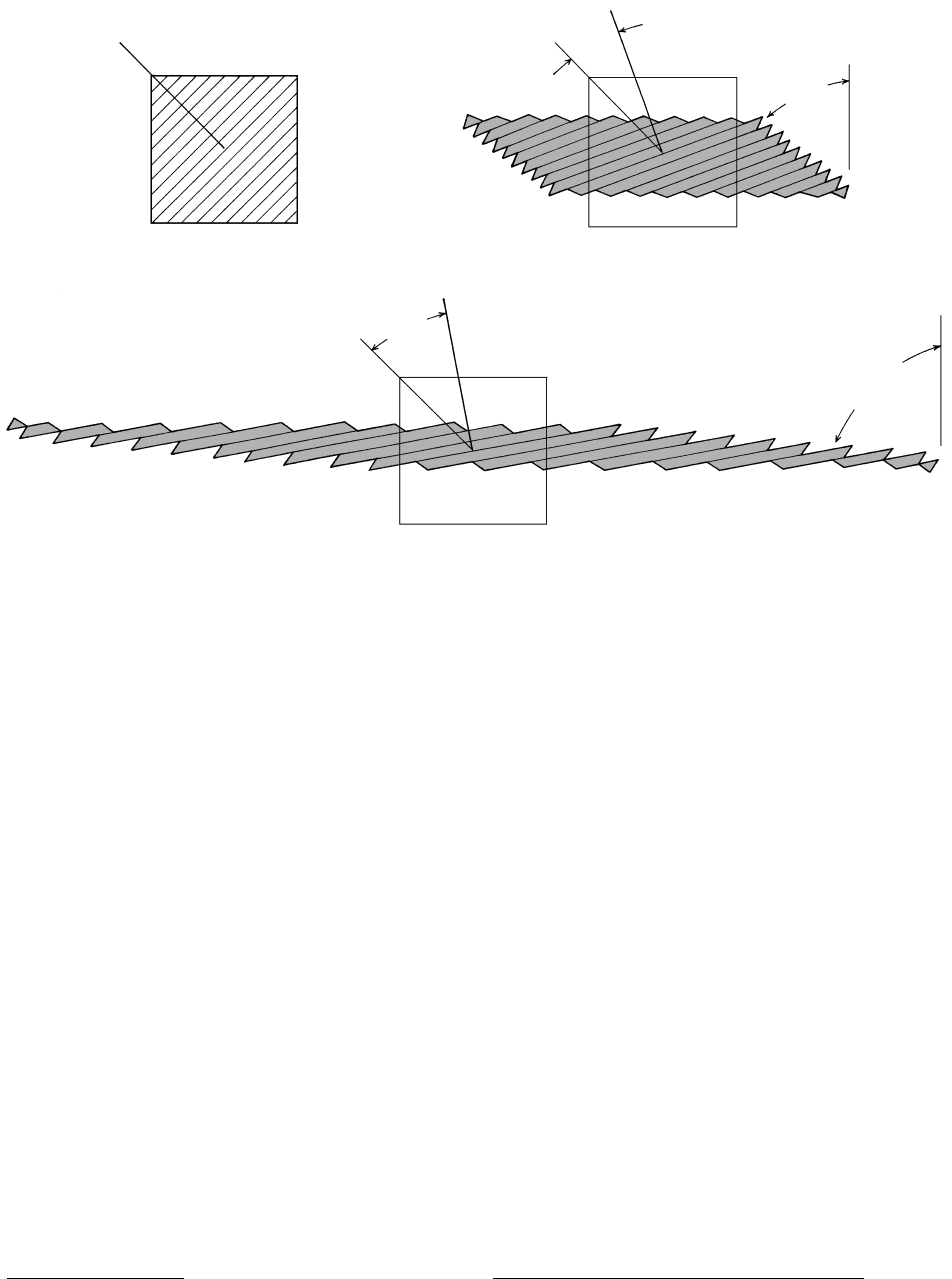
534 Igneous and Metamorphic Petrology
Original unstrained
grain
Flattening
1
50%
Extension
1
160%
25°
35°
52°
Flattening
1
75%
Extension
1
540%
85°
17.15 Development of a flattened single grain by constant-volume, intracrystalline plastic slip. Two-dimensional model grain is strained by
pure shear as if constricted between the jaws of a vise. (a) Original unstrained grain showing potential slip planes and perpendicular
lattice direction (single line). This grain model could represent the slip system in low T quartz with basal (0001) slip planes and the
crystallographic c-axis as the lattice direction. (b) Flattening strain (Section 8.1.2)
1
50% with a corresponding extension (elonga-
tion) of 160%. The crystal lattice has experienced an internal rotation of the crystallographic axis and slip planes by 25° and an external
rotation of the edge of the grain by 52°. (c) Extreme strain and rotation that has created a ribbonlike grain shape by slip on oblique
planes; compare Figure 17.14b. The constraints on this strain model are that the top and bottom faces of the grain remain parallel and
constant in overall orientation and that the dimensions of the lamellae bounded by slip planes remain constant. Redrawn from Hobbs
et al. (1976).
some crystals. Deformation twins may be thin lamellae
and distributed throughout the crystal, as in carbonates
(Figure 17.16c), or they can take over most, and pos-
sibly all, of the crystal, depending upon circumstances.
Twinning seems to be easier in coarser aggregates than
in finer. Wedge-shaped or curved multiple deformation
twins are common in strained plagioclase (Figures
15.17 and 17.12); they contrast with ubiquitous plagio-
clase growth twins in undeformed magmatic rocks that
are straight and parallel and formed while free-floating
crystals were growing in a silicate melt.
In deformation twinning of calcite, the maximum
achievable shear strain (change in shape) is only 35%
(Figure 17.16). This limitation precludes its inclusion
in Figure 17.9, which refers to ductile mechanisms
allowing large permanent deformation. The geo-
metric aspects of twinning in limestones and low-grade
marbles can be used to infer something of the ori-
entation of the responsible principal stresses and their
magnitudes (Law, 1990).
Kinking and Bending. Differential slip, or twin glid-
ing in some instances, can be restricted to a kink
band in which the slip planes are oriented several
tens of degrees from the same planes in the essentially
undeformed parts of the crystal on both sides (Figure
17.17). Kinking is most commonly found in crystals
that have only one easy slip plane, especially micas, but
also enstatite and kyanite. Kink bands commonly occur
in conjugate pairs more or less symmetrically oriented
to the applied compressive stress directions. Bending
of a crystal lattice at the margins of a kink band or in a
more distributed fashion throughout an entire crystal is
a paradox. Bending requires differential movement
between layers of the lattice, as in bending a pack of
cards. But the bent lattice in Figure 17.18a is inconsist-
ent with plastic slip in Figure 17.11c, where the trans-
lation is only by integral multiples of lattice spacings,
leaving “good” crystal continuously across the plane of
movement. To maintain continuity throughout most of
the bent crystal lattice it is necessary to postulate the
existence of geometrically necessary stacking imperfec-
tions, or defects, shown in Figure 17.18b. These crystal
defects are critically important in plastic strain and are
discussed in some detail below.
Translation Gliding of Crystals in Aggregates. A com-
puter model of deformation of an hypothetical two-
dimensional array of randomly oriented hexagons
possessing one slip plane illustrates what might happen
(a)
(c)
(b)
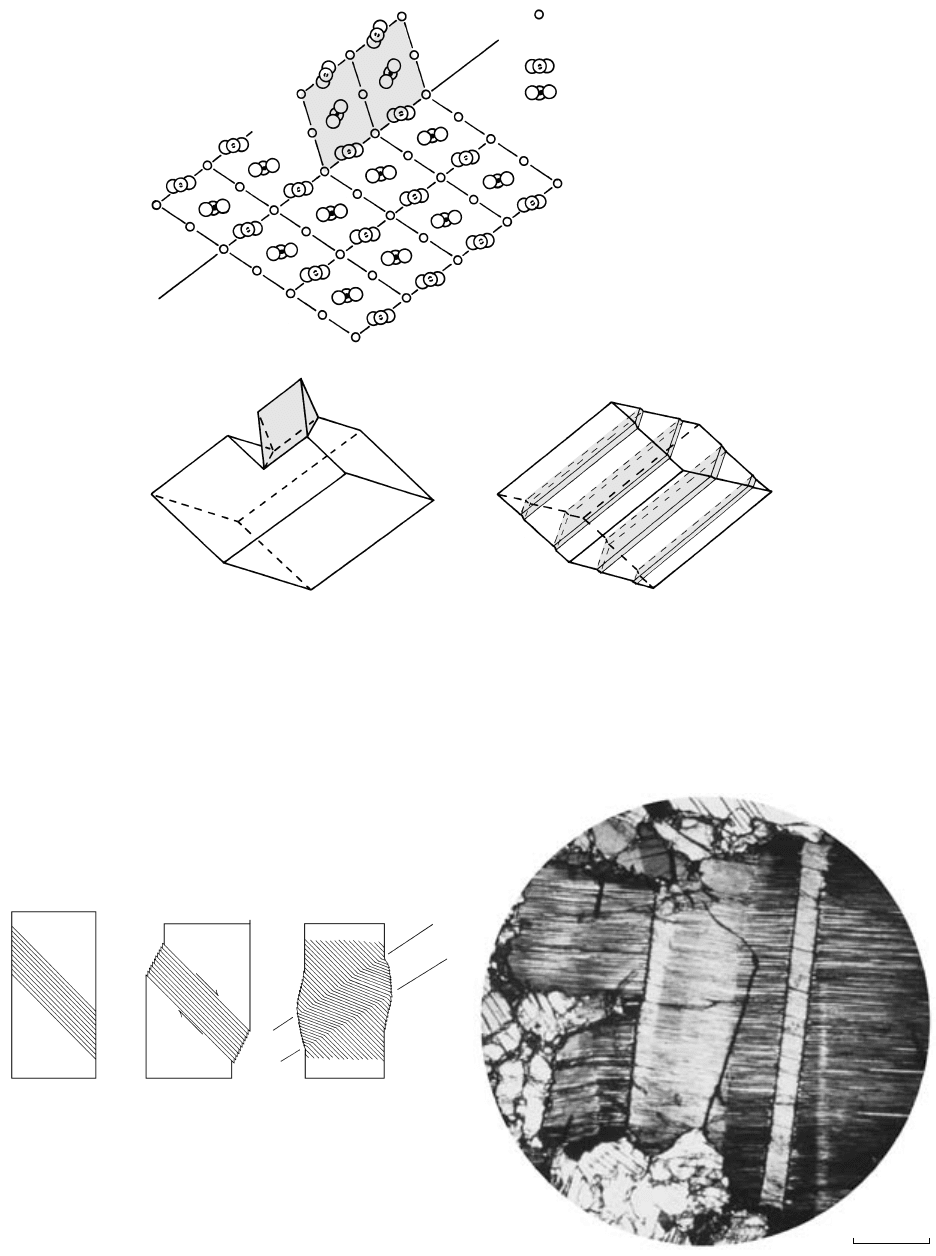
Evolution of Imposed Metamorphic Fabrics: Processes and Kinetics
535
(a)
Plane
Twin
Ca
2
CO
3
2
(b) (c)
17.16 Twin gliding in calcite on {1102}. (a) Atomic structure across the twin plane showing a small twin (shaded). (b) A small wedge-shaped
twin (shaded) can be produced by compressing the edge of a calcite cleavage rhombohedron with a knife perpendicular to its c-axis.
Twinning occurs at a shear stress of only 100 bar. (c) Lamellar twins (shaded) in a calcite rhomb.
Unstrained,
showing potential
slip planes
Plastically
strained, ends
not constrained
Plastically
strained, ends
constrained
Kink
band
(a)
(b)
0mm1
17.17 Kink bands. (a) Unstrained and plastically strained cylinders of a single crystal with a set of parallel slip planes. The kink band developed
in the third cylinder represents what happens in a crystal that is strained while confined within an aggregate. Extension of a confined
crystal can also produce a kink band. Redrawn from Higgs and Handin (1959). (b) Photomicrograph under cross-polarized light of kink
bands in a plastically strained enstatite crystal in a peridotite.
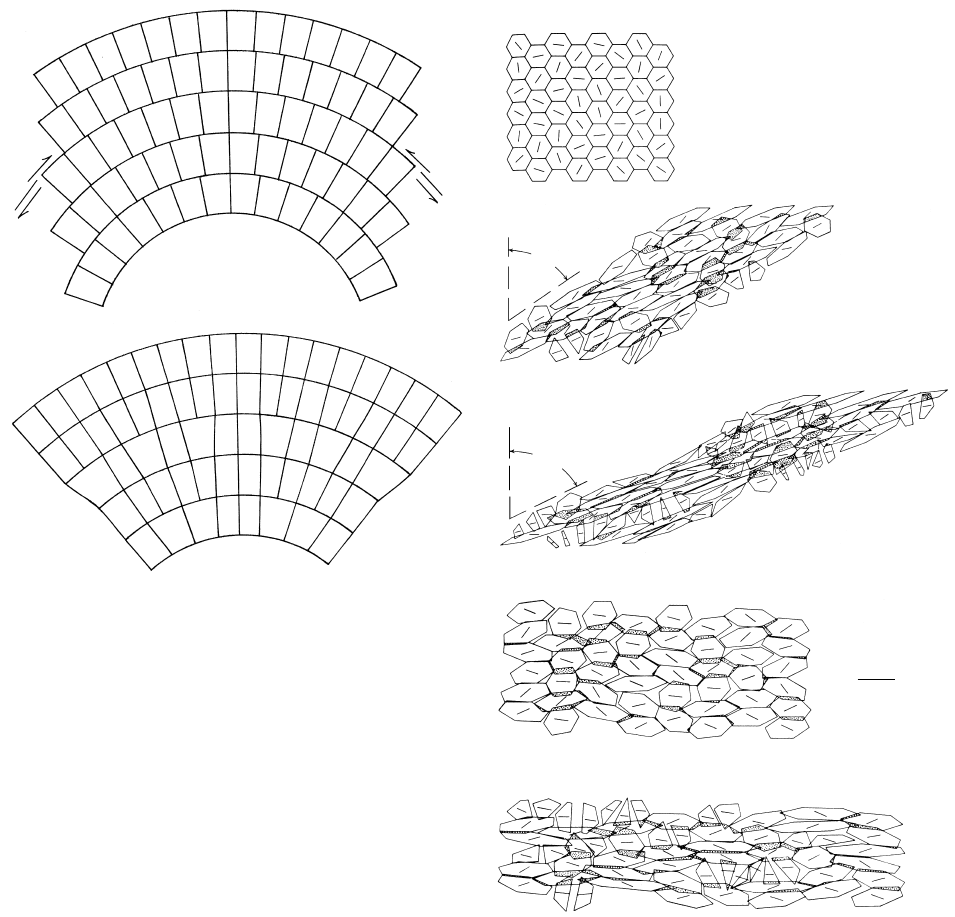
In aggregates of grains that have random crystallo-
graphic orientation, plastic deformation is obviously
greatly enhanced if the grains are of high-symmetry
and possess multiple slip planes, because of the high
probability that the resolved shear stress is sufficient to
536 Igneous and Metamorphic Petrology
(a)
(b)
17.18 Schematic bent crystal lattice. (a) The arched “card deck”
model does not correspond to bending of a crystal by plastic
slip because of the discontinuity of the lattice across the
surfaces of differential movement. (b) Another model mostly
preserves continuity but embodies geometrically necessary im-
perfections, or edge dislocations, at the ends of half lattice
planes extending part way through the lattice perpendicular to
the plane of the drawing.
(a)
(b)
(c) Simple shear
64°
Undeformed aggregate;
random slip directions
55°
(d)
(e)
Pure shear
35%
49%
l l
0
l
0
17.19 Computer models of progressive deformation in grain aggre-
gates. (a) Undeformed aggregate. Each grain has one slip
direction and they are randomly oriented in the aggregate. (b)
and (c) Progressive simple shear. Compare Figure 17.20. Note
ruptured grains and overlaps (stippled) and gaps between
grains. (d) and (e) Progressive pure shear. (f) Histograms
showing increasing preferred lattice orientation of slip direc-
tion during progressive strain; dashed lines in histograms for
simple shear are orientations of long diagonal of strained
aggregate. From Etchecopar A. 1977. A plane kinematic model
of progressive deformation in a polycrystalline aggregate.
Tectonophys. 39: 121–139. Reproduced with permission pend-
ing from Elsevier Science Copyright © 1977.
in a simple plastically deformed aggregate of grains
of a low-symmetry crystalline phase (Figure 17.19).
The array was homogeneously deformed by pure and
simple shear (Special Interest Box 17.1, Figures 17.20
and 17.21). In the model, the hexagons are allowed to
slip, rotate, move past neighbors, or even rupture, all
the while striving to minimize gaps or overlaps between
them. Results include the following points of interest:
1. Intergrain voids and overlaps are considerable, even
though the modeling procedure attempted to min-
imize them. In a real rock undergoing deformation,
these voids and overlaps must be compensated
for by bending, kinking, grain boundary sliding,
recrystallization, and pressure solution.
2. Slip planes nearly parallel to the plane of flattening
in the array have low resolved shear stress and con-
sequently host grains strain less.
3. Increasing bulk strain of the aggregate results in a
stronger preferred orientation of slip planes and
therefore lattices as well as of grain shape. This has
an important bearing on the anisotropic fabric of
tectonites discussed later.
